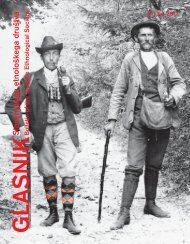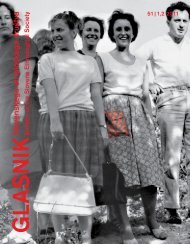lovenskega etnološkega društva - Slovensko etnološko društvo
lovenskega etnološkega društva - Slovensko etnološko društvo
lovenskega etnološkega društva - Slovensko etnološko društvo
You also want an ePaper? Increase the reach of your titles
YUMPU automatically turns print PDFs into web optimized ePapers that Google loves.
Razglabljanja Vito Hazler<br />
SIMČIČ, Zvonimir: Vino med ljudsko modrostjo in sodobno znanostjo. Trst:<br />
Založništvo tržaškega tiska, 1987.<br />
SIMONIČ, Monika: Čušev tekst o viničarjih, Mickina zgodba viničarstva.<br />
Ljubljana: Diplomska naloga na Oddelku za etnologijo in kulturno antropologijo<br />
Filozofske fakultete Univerze v Ljubljani, 1997.<br />
SIMONIČ-ROŠKAR, Monika: Viničarstvo v Halozah in Slovenskih goricah<br />
v drugi polovici 19. stol. do prenehanja viničarstva v letih po koncu druge<br />
svetovne vojne. V: Andrej Brence (ur.), Zbornik Pokrajinskega muzeja Ptuj<br />
1. Ptuj: Pokrajinski muzej Ptuj, 2003, 138–150.<br />
SKALICKÝ, Bohuslav: Kletarstvo. Ljubljana: Zvezna tiskarna in knjigarna,<br />
1924.<br />
SKAZA, Anton: Ljubiteljsko kletarstvo. S prispevkoma prof. Dušana Moškona<br />
»Arhitektura naših vinorodnih krajev včeraj in danes« in Dionizija<br />
Amfore »Umni vinogradnik in vinska kultura«. Maribor: Založba Obzorja,<br />
1982.<br />
STOPAR, Ivan: Gradovi, graščine in dvorci na slovenskem Štajerskem. Ljubljana:<br />
Znanstveni inštitut Filozofske fakultete Univerze Edvarda Kardelja v<br />
Ljubljani, 1982.<br />
STOPAR, Ivan in Primož Premzl: Joseph Franz Kaiser, Stara Kaiserjeva suita<br />
1824–1833: litografirane podobe slovenještajerskih mest, trgov in dvorcev.<br />
Maribor: Umetniški kabinet Primož Premzl, 1999 (več vrst paginacij).<br />
ŠESTAN, Ivan: Vino i tradicija. Katalog razstave. Zagreb: Etnografski muzej<br />
u Zagrebu, 1998.<br />
ŠIKOVEC, Slavica: Sodobno kletarstvo. Ljubljana: Časopisno založniško<br />
podjetje Kmečki glas, 1985.<br />
ŠTABI, Snežana in Igor Kramberger (ur.): Podobe prednikov: Zapiski Janeza<br />
Trdine iz obdobja 1870–1879. 29 zvezkov rokopisa v treh knjigah. Ljubljana:<br />
Krt, 1987.<br />
Slovene Wine Cellars<br />
TERČELJ, Dušan: Kultura vina na Slovenskem. Ptuj in Ljubljana: Tovarna<br />
tradicij in Slovenski etnografski muzej, 2007.<br />
VALENČIČ, Vlado: Vinogradništvo. V: Pavle Blaznik, Bogo Grafenauer in<br />
Sergij Vilfan (ur.), Gospodarska in družbena zgodovina Slovencev: zgodovina<br />
agrarnih panog. I. zvezek Agrarno gospodarstvo. Ljubljana: Državna<br />
založba Slovenije, 1970.<br />
VERTOVEC (VERTOVZ), Matija: Vinoréja. Ljubljana: natisnil Joshef Blasnik,<br />
1845.<br />
VILFAN, Sergij: Od vinskega hrama do bajte (Prispevek k zgodovini bajtarstva<br />
in gostaštva v dolenjskih vinogradih). Slovenski etnograf 5. Ljubljana,<br />
1952, 107–142.<br />
VILFAN, Sergij: Delavci v agrarnem gospodarstvu. V: Gospodarska in družbena<br />
zgodovina Slovencev: zgodovina agrarnih panog. Zvezek II. Ljubljana:<br />
Državna založba Slovenije, 1980, 355–402.<br />
VINSKA KLET Jeruzalem-Ormož, http://sl.jeruzalem-ormoz.si/o_nas/blagovna_znamka_jeruzalem_ormoz,<br />
25. 10. 2009.<br />
VODUŠEK, Nataša (ur.): Vodnik po kulturni in naravni dediščini občine Ormož.<br />
Ormož: Občina Ormož, 1998.<br />
VOJAKOVIĆ, Petra: Gradbeni materiali v prazgodovini: primer arheološkega<br />
najdišča Ljubljana – nova soseska Tribuna. Ljubljana: Oddelek za<br />
arheologijo Filozofske fakultete Univerze v Ljubljani, 2009 (seminar podiplomskega<br />
študija, mentor V. Hazler).<br />
VOŠNJAK, Josip: Umno kletarstvo: Slovenskim vinorejcem v poduk. Celovec:<br />
Družba sv. Mohorja v Celovcu, 1873.<br />
ŽONTAR, Josip: Soseski (cerkveni) »hisi« v Beli krajini. V: Slovenski etnograf<br />
10, 1957: 77–80.<br />
Architecture is the result of past and present endeavors to create satisfactory conditions for living and working. Together with buildings<br />
equipped with a cellar and other cellar storage rooms used for wine-making purposes, wine cellars are an important segment of architecture.<br />
Their structure and shapes are the result of several thousand years of the tradition of wine-growing in Slovenia. The time and place of their<br />
origin; their building materials and methods; their purpose; and particularly the social background of their owners are very diverse. Very<br />
old wine cellars, which have been preserved to the present, represent an important step toward our understanding of the development of<br />
architecture. In certain areas such as the vineland in the municipality of Šmartno ob Paki, the still-preserved buildings connected with viticulture<br />
and wine-growing are particularly significant because of their original structures combining living quarters, which were comprised<br />
of one or two rooms, and the simply designed rooms intended for the production of wine. Such buildings were namely not designed solely<br />
for the production of wine from grapes and for further wine storage but also served, either periodically or permanently, as housing accommodations<br />
for the vineyard’s owner, his family and relatives, or for hired laborers.<br />
Due to their interesting design and shape, a number of wine cellars represent a tourist attraction in viticultural areas and in places with a<br />
well-developed wine trade. Erected next to the home of the wine-grower and his family, some of these cellars, also known as the repnice,<br />
are in the form of tunnels dug out of firmly packed river sand and situated in the centre of vineyards in Bizeljsko. A remarkable feat of<br />
architecture, some wine cellars have been dug out underneath towns such as Maribor and Ptuj.<br />
Wine cellars also present an opportunity for socializing and for strengthening business ties. Situated in the middle of a vineyard, such cellars<br />
have become an increasingly popular location for leisure activities. In addition to their »weekend vineyard migrations«, some people spend<br />
their entire holidays there, or even move there after retirement. Modern wine cellars are usually miniature versions of comfortable family<br />
houses and a popular destination for their owners and friends.<br />
13<br />
Glasnik SED 49|3,4 2009




